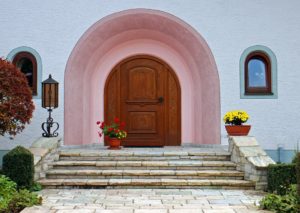Wood, Fibreglass or Steel? How to find a right front door
 Your front door plays a critical role in keeping your home secure. However, it does a lot of other things too. A front door says a lot about your personality and also improves the market value of your home. But how to choose the right front door, for it can indeed be an overwhelming process?
Your front door plays a critical role in keeping your home secure. However, it does a lot of other things too. A front door says a lot about your personality and also improves the market value of your home. But how to choose the right front door, for it can indeed be an overwhelming process?
Here is a quick guide on what material works best to meet your requirements in terms of budget, durability as well as style.
Solid wood doors
Though expensive than other options (fibreglass and steel, for example), doors made of wood remain the first choice for people who are ready to spend and prefer a natural look on their doors.
Why?
- High resistance to kick-ins, and wear and tear
- Doesn’t rust or dent
- Easy to repair
- Variety of wood to choose from such as fir, mahogany and oak
- Works for all kinds of architectural style
- Have a long life-span, especially if you have selected high quality wood.
- Reduce the noise that comes from outdoors.
- Can be customized and cut according to your requirements and personal choice.
Why not? As we mentioned, wood doors are quite expensive. These doors also need regular maintenance and upkeep such as painting or varnishing to keep looking their best. Another disadvantage would be that wood doors can absorb moisture if not sealed at the time of installation.
Fibreglass door
For those on budget but who still want to achieve the natural appeal and texture of wood, fibreglass doors make for a great choice and the right front door.
Why?
- Can be made to look like real wood
- Offers superior security than wood, if installed properly.
- Better resistance to rust, dents and wear and tear
- Need little maintenance and upkeep
- Reasonably priced, though still higher than steel doors.
- Offers high insulation
- Wide variety of color, styles and textures to choose from
- Can be easily painted
Why not? Low-quality fibreglass doors are prone to cracking under high impact.
Steel doors
Why?
- Easy to repair and maintain
- Offers good insulation value and energy efficiency
Why not? Steel doors are prone to denting and rusting, especially if you live near a coastal area.
What else can you do to make your front door is at its most secure
- Reinforced strike plates and doorjambs (by attaching a steel plate) can improve a door’s resistance against kick-in manifolds.
- Use a high-quality deadbolt lock that is attached with at least 3 inches long to extend beyond the doorjamb for added strength to withstand a kick-in.
- Planning to install a door with glass inserts? You may want to consider installing a double-cylinder dead-bolt lock. A glass sidelight may make it easy for a burglar to simply break the glass and open the door. Some authorities ban the use of double cylinder deadbolts as these locks may impede the evacuation in case of emergency. These locks need a key from both the outside and inside. If you are not able to find a key well in time in case there is a fire, you may get stuck inside.
- Install a digital peephole to proactively check who is knocking at the door.
